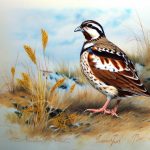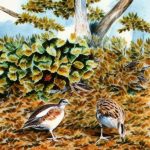Bobwhite quail, also known as northern bobwhite, are popular game birds native to North America. They are known for their distinctive call and are often sought after by hunters. In recent years, there has been an increase in interest in breeding bobwhite quail for both hunting and conservation purposes. Breeding bobwhite quail can be a rewarding experience, but it also comes with its own set of challenges, particularly when it comes to managing aggression within the flock.
Breeding bobwhite quail requires careful attention to their social dynamics, as they are known to be territorial and can exhibit aggressive behavior towards one another. Understanding the signs of aggression, the hierarchy within the flock, and strategies for managing aggression are all essential aspects of successful bobwhite quail breeding. In this article, we will explore these topics in depth and provide valuable insights for breeders looking to effectively manage aggression in their bobwhite quail flock.
Table of Contents
- 1 Signs of Aggression in Bobwhite Quail
- 2 Understanding the Hierarchy of Bobwhite Quail
- 3 Strategies for Managing Aggression in Bobwhite Quail
- 4 Providing Adequate Space and Resources for Bobwhite Quail
- 5 Introducing New Birds to the Bobwhite Quail Flock
- 6 Seeking Professional Advice for Aggressive Bobwhite Quail Behavior
- 7 FAQs
Key Takeaways
- Bobwhite quail breeding requires understanding their social structure and behavior
- Signs of aggression in bobwhite quail include pecking, chasing, and feather plucking
- Bobwhite quail have a strict hierarchy within their flock
- Managing aggression in bobwhite quail involves providing enough space and resources
- Introducing new birds to the flock should be done carefully to minimize aggression
- Seeking professional advice is important for dealing with aggressive bobwhite quail behavior
Signs of Aggression in Bobwhite Quail
Aggression in bobwhite quail can manifest in various ways, and it is important for breeders to be able to recognize the signs in order to address the issue effectively. One common sign of aggression is feather pecking, where one bird will aggressively peck at the feathers of another bird, often causing injury. This behavior can be particularly problematic in confined spaces where birds may feel stressed or overcrowded. Another sign of aggression is sparring, where birds engage in physical fights, often resulting in injuries or even death.
Additionally, aggressive bobwhite quail may exhibit territorial behavior, such as chasing or cornering other birds within the flock. This can lead to increased stress and decreased overall well-being for the birds involved. It is important for breeders to closely monitor their flock for these signs of aggression and take proactive measures to address the issue before it escalates. By understanding the behaviors associated with aggression, breeders can intervene early and implement strategies to manage and minimize aggressive behavior within their bobwhite quail flock.
Understanding the Hierarchy of Bobwhite Quail
Bobwhite quail are social birds that establish a hierarchy within their flock. Understanding this hierarchy is crucial for breeders looking to manage aggression effectively. In a typical bobwhite quail flock, there will be dominant birds that assert their authority over others through displays of aggression and territorial behavior. These dominant birds will often have access to the best resources, such as food and nesting sites, while subordinate birds may be forced to compete for these resources.
It is important for breeders to recognize and respect the natural hierarchy within the flock while also taking steps to prevent excessive aggression and bullying. By understanding the social dynamics at play, breeders can implement strategies to ensure that all birds have access to essential resources and are able to coexist peacefully within the flock. This may involve providing multiple feeding and watering stations, as well as creating ample hiding spots and perches to allow subordinate birds to escape aggressive individuals. By promoting a more balanced hierarchy within the flock, breeders can help minimize aggressive behavior and create a more harmonious living environment for their bobwhite quail.
Strategies for Managing Aggression in Bobwhite Quail
Managing aggression in bobwhite quail requires a multi-faceted approach that addresses both the physical and social aspects of their environment. One effective strategy is to provide ample space for the birds to move around and establish their own territories. Overcrowding can lead to increased stress and aggression, so ensuring that the birds have enough room to spread out can help minimize conflict within the flock.
Another important strategy is to provide enrichment activities that encourage natural behaviors and reduce boredom. This can include providing perches, hiding spots, and foraging opportunities that allow the birds to engage in natural behaviors and alleviate stress. Additionally, providing multiple feeding and watering stations can help reduce competition for resources and prevent dominant birds from monopolizing essential supplies.
Breeders should also consider the composition of their flock when managing aggression. Mixing different age groups or introducing new birds into an established flock can disrupt the social dynamics and lead to increased aggression. Careful consideration should be given to introducing new birds gradually and monitoring their interactions closely to prevent conflict.
Finally, breeders should be prepared to intervene if aggressive behavior does occur. This may involve separating aggressive individuals from the rest of the flock or providing additional hiding spots for subordinate birds to escape aggression. By implementing these strategies, breeders can effectively manage aggression in their bobwhite quail flock and create a more harmonious living environment for their birds.
Providing Adequate Space and Resources for Bobwhite Quail
One of the most important factors in managing aggression in bobwhite quail is providing adequate space and resources for the birds. Overcrowding can lead to increased stress and competition for resources, which can in turn lead to aggressive behavior within the flock. Breeders should ensure that their housing facilities provide enough room for the birds to move around freely and establish their own territories.
In addition to space, providing ample resources such as food, water, and nesting sites is essential for minimizing aggression within the flock. Multiple feeding and watering stations should be provided to prevent dominant birds from monopolizing essential resources and forcing subordinate birds to go without. Nesting sites should also be plentiful to prevent competition for breeding spaces, which can lead to increased aggression during mating season.
Breeders should also consider the layout of their housing facilities when managing aggression. Providing hiding spots, perches, and other enrichment activities can help reduce stress and provide opportunities for subordinate birds to escape aggressive individuals. By creating a more enriched environment, breeders can help minimize conflict within the flock and promote a more peaceful coexistence among their bobwhite quail.
Introducing New Birds to the Bobwhite Quail Flock

Introducing new birds into an established bobwhite quail flock can be a delicate process that requires careful planning and monitoring. Mixing different age groups or introducing new birds without proper acclimation can disrupt the social dynamics within the flock and lead to increased aggression. Breeders should take steps to introduce new birds gradually and monitor their interactions closely to prevent conflict.
One effective strategy for introducing new birds is to use a “buddy system” where new birds are paired with established members of the flock. This allows the new birds to integrate more smoothly into the social structure and reduces the likelihood of aggressive behavior towards them. Breeders should also consider introducing new birds during times of low stress, such as during the off-season or when there are no breeding activities taking place.
It is important for breeders to closely monitor the interactions between new and established birds during the introduction process. Signs of aggression should be addressed immediately, and aggressive individuals may need to be separated from the rest of the flock temporarily until they can be reintegrated without causing conflict. By taking a gradual and cautious approach to introducing new birds, breeders can minimize disruption within the flock and reduce the likelihood of aggressive behavior towards new additions.
Seeking Professional Advice for Aggressive Bobwhite Quail Behavior
In some cases, managing aggression in bobwhite quail may require professional intervention. If breeders are struggling to address aggressive behavior within their flock despite implementing various strategies, seeking advice from a professional with experience in avian behavior may be necessary. A professional can provide valuable insights into the underlying causes of aggression within the flock and offer tailored solutions to address the issue effectively.
Professional advice may involve conducting a thorough assessment of the housing facilities, social dynamics within the flock, and individual bird behavior to identify potential triggers for aggression. Based on this assessment, a professional can recommend specific changes or interventions that may help minimize aggressive behavior and promote a more harmonious living environment for the bobwhite quail.
Additionally, a professional can provide guidance on best practices for managing aggression in bobwhite quail based on their experience working with similar species. This may include recommendations for housing design, environmental enrichment, social dynamics management, and other strategies tailored to the specific needs of bobwhite quail.
In conclusion, managing aggression in bobwhite quail requires a comprehensive understanding of their social dynamics, as well as proactive strategies for providing adequate space and resources, introducing new birds, and seeking professional advice when necessary. By taking a proactive approach to managing aggression, breeders can create a more harmonious living environment for their bobwhite quail and ensure the well-being of their flock.
If you’re interested in learning more about the behavior of quails, you might want to check out an article on Poultry Wizard about bobwhite quail breeding pairs and their interactions with other females. This article provides valuable insights into the dynamics of quail breeding and how certain pairs may exhibit aggressive behavior towards other females. You can find the article here.
FAQs
What is a bobwhite quail breeding pair?
A bobwhite quail breeding pair consists of a male and female quail that are kept together for the purpose of breeding and producing offspring.
Why are the breeding pair picking on other female quails?
Breeding pairs of bobwhite quails may pick on other female quails in their environment as a way to establish dominance and protect their territory. This behavior is common in many bird species and is a natural part of their social dynamics.
How can I prevent the breeding pair from picking on other female quails?
To prevent the breeding pair from picking on other female quails, it is important to provide enough space and hiding spots in the enclosure to allow the other females to escape and avoid confrontation. Additionally, providing multiple feeding and watering stations can help reduce competition and aggression among the quails.
Are there any other reasons why the breeding pair may be picking on other female quails?
In some cases, the breeding pair may pick on other female quails if they are feeling stressed or if there are not enough resources, such as food and water, available for all the quails in the enclosure. It is important to ensure that the quails’ basic needs are being met to prevent aggression and bullying behavior.
Meet Walter, the feathered-friend fanatic of Florida! Nestled in the sunshine state, Walter struts through life with his feathered companions, clucking his way to happiness. With a coop that’s fancier than a five-star hotel, he’s the Don Juan of the chicken world. When he’s not teaching his hens to do the cha-cha, you’ll find him in a heated debate with his prized rooster, Sir Clucks-a-Lot. Walter’s poultry passion is no yolk; he’s the sunny-side-up guy you never knew you needed in your flock of friends!







